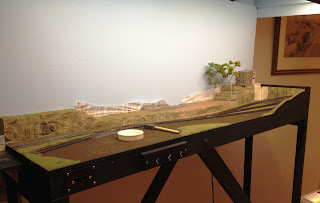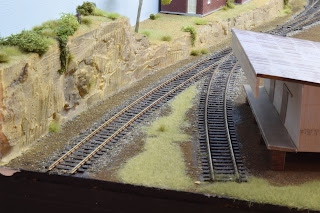Finished work for the year yesterday and I've had some time today to sort through the 'to-do' list on the layout. So, lucky reader, I can finally detail the construction of the road overbridge.
In tracking down examples I found that most of the bridges on the goods lines in Sydney were built to similar designs. I say similar because although a number of the features are standard, such as the shape and layout of the brick sides, the bridge height, supports and width had small variances to fit into their location.
Built around the same time as the goods lines' bridges was this example at Sodwalls near Tarana in NSW. This was the photo I largely worked from to develop the bridge sides and brickwork. In the absence of plans I counted the individual bricks to work out my dimensions. A number of times.
Note the pattern changes for the last layer at the top of the bridge sides. This is called 'coping.'
Note the pattern changes for the last layer at the top of the bridge sides. This is called 'coping.'

So as not to waste the nicely printed brickwork sheets I had, I printed a sheet in black and white at home and devised how I was going to assemble it, and to roughly gauge whether the height would be sufficient above the wagons.
Looking from the railside on at the prototype, I noticed that the abutments sit a few bricks proud of the raised supports on the bridge. To replicate this effect, I first cut out the raised section for the bridge sides, followed by the abutments, before measuring a suitable length of cardboard to glue behind and across the whole lot, which attaches the abutments together. I also needed a packing piece of cardboard cut to size to fit between this part and the bridge sides above the abutments. The evergreen styrene I-beam will represent the steel horizontal supports.
Next I added the brickpaper. I used TX02 in brown brick from Scale Scenes in OO scale, laser printed at Officeworks. I cut the paper out with a sharp hobby knife and a ruler. For the larger sections I just used a UHU gluestick. For the more fiddly bits I squirted a small blob of PVA glue onto the workbench and spread it onto the job with a tooth pick. The hardest part is adding the coping on the top of the walls. I need a few goes at this.
I added the rollingstock back to this section of the yard again to check that everything still fit. Owing it to it being on public display straight after completion I was a little more paranoid than normal about getting it all working.
I added the rollingstock back to this section of the yard again to check that everything still fit. Owing it to it being on public display straight after completion I was a little more paranoid than normal about getting it all working.

For the pylons I used various evergreen styrene shapes I had leftover from previous builds. The only new addition was smaller I-beams for the vertical supports. The bridge variant I'm building is taller than the example above at Sodwalls, so the pattern of bracing I wanted to replicate wasn't going to fit.
Instead, I'd found a few different designs while looking at the Punchbowl Rd overbridge at the south end of Enfield yard in Sydney and elsewhere. I was comfortable that the design I did finally settle on wouldn't look out of place. The L-beam jutting off to the left will meet it's reflection in the mirror, completing the illusion of a wider bridge.
And here's the final product. To save time I took a risk and painted the styrene in Krylon camo brown without priming it first, coating it in dullcote and applying grey pastel powders over the top to complete the structure. The footings were made from the same brick pattern with an uncoloured cardboard cap to represent a layer of concrete.
The roadway itself was simply more flat cardboard with a layer of Scalescenes' pavement and tarmac glued over the top. All up the build took just a few nights.
Hope that stimulates some thoughts of your own over the holidays. I hope to get another post in between now and the new year, but thanks for following this year and sharing your comments. I appreciate the feedback.
Cheers!
Hope that stimulates some thoughts of your own over the holidays. I hope to get another post in between now and the new year, but thanks for following this year and sharing your comments. I appreciate the feedback.
Cheers!


















































